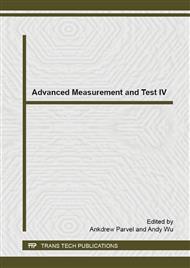[1]
PEI Fang, LUO Ze-jiao, PENG Jin-jin, et al. Phenols Pollutants in Soil and Shallow Groundwater of a Retired Refinery Site[J]. ENVIRONMENTAL SCIENCE. 2012, 33(12): 4251-4255.
Google Scholar
[2]
WU Zheng-yong, ZHAO Gao-feng, ZHOU Huai-dong, et al. Pollution Characteristics and Potential Risks of Phenolic Compounds in Schistosomiasis Epidemic Areas[J]. ENVIRONMENTAL SCIENCE. 2012, 33(5): 1682-1686.
Google Scholar
[3]
LIU Xiao-qing, LI Guo-bao, WU Hai-zhen, et al. The Degradation and Transfer of Phenolic Compounds During the Trestment Processes of Cokong Wastewater[J]. ENVIRONMENTAL CHEMISTRY. 2012, 31(10): 1487-1493.
Google Scholar
[4]
WU Zheng-yong, ZHAO Gao-feng, ZHOU Huai-dong, et al. Distribution Characteristics and Potential Risks of Phenols in the Rainy Season Surface Water from Three Gorges Reservoir[J]. ENVIRONMENTAL SCIENCE. 2012, 33(8): 2580-2585.
Google Scholar
[5]
WANG Wan-hua, LIU Zheng-tao, JIANG Fu-xin, et al. Status Quo of Organic Pollutants in Water at Estuary of the Yangtze River[J]. Journal of Ecology and Rural Environment. 2007, 23(1): 92-95.
Google Scholar
[6]
SONG Yuan-zhi, ZHANG Wei-guang, YING Qi-fan, et al. Theoretical Analysis on Retention Behavior of Phenols in Inversed-phase High Performance Liquid Chromatagraphy[J]. CHINESE JOURNAL OF CHEMICAL PHYSICS. 2005, 18(3): 362-366.
Google Scholar
[7]
MENG Lei, ZHENG Xian-Fu, WANG Yong-Shan, et al. Determination of Nitrophenol in Industrial Waste Water by High Performance Liquid Chromatography[J]. Chinese Journal of Spectroscopy Laboratory. 2007, 24(5): 868-871.
Google Scholar
[8]
ZHOU Xiao, WANG Hui-qi, FAN Shu-juan, et al. Microchip-based Cloud Point Extraction System and Its Application to Determination of p-Nitrophenol in Water Samples[J]. 2013, 41(12): 1905-(1909).
DOI: 10.3724/sp.j.1096.2013.30555
Google Scholar
[9]
HE Miao, RAO Zhu, SU Jin, et al. High Performance Liquid Chromatographic Determination of Phenol Compounds in Ground Surface Water Samples with GDX-502 Resin Concentration[J]. ROCK AND MINERAL ANALYSIS. 2007, 26(2): 101-104.
Google Scholar
[10]
XUE Feng-li, LI Yan, YANG Rui-qiang, et al. Determination of Phenols in Water by Solid Phase Microextraction with High Performance Liquid Chromatography[J]. CHINA WATER & WASTEWATER. 2006, 66(16): 81-83.
Google Scholar
[11]
JIANG Li-na, SHE Zong-lian, JIN Chun-ji, et al. Effects of Different Co-substrates on Degradation of Nitrophenols Using UASB Reactors[J]. ENVIRONMENTAL SCIENCE. 2007, 28(10): 2230-2235.
Google Scholar


